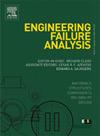Investigating the effects of the moisture content of filling and shear rate on the shear characteristics of rock-like materials with joint
IF 4.4
2区 工程技术
Q1 ENGINEERING, MECHANICAL
引用次数: 0
Abstract
Rock joints in fault zones are commonly filled with fault gouge, where clay fillings are common. Until now, the shear characteristics of filled rock joints under different moisture contents and shear rates have not been well understood. This work investigates the mechanical behaviour of rock-like materials with clay-filled joints under compression-shear loading. A self-developed rock shear test system was used to conduct direct shear tests on rock-like materials under three normal stresses and five shear rates. Six types of natural red clay with different moisture contents were selected for filling. The coupling effects of the moisture content and shear rate on the mechanical properties of rock-like samples with clay-filled joints were investigated. Furthermore, the failure characteristics of the failure surfaces of rock-like materials after shearing were scanned via 3D scanning. The test results show that the moisture content of fillings and shear rate significantly affect the shear characteristics of rock-like materials with filled joints. The plastic limit moisture content is a critical point where the shear rate has the least effect on the shear strength. Under dry soil filling conditions, the degree of shear damage on the shear plane is the smallest. The present results can provide guidance for slope protection projects.
求助全文
约1分钟内获得全文
求助全文
来源期刊

Engineering Failure Analysis
工程技术-材料科学:表征与测试
CiteScore
7.70
自引率
20.00%
发文量
956
审稿时长
47 days
期刊介绍:
Engineering Failure Analysis publishes research papers describing the analysis of engineering failures and related studies.
Papers relating to the structure, properties and behaviour of engineering materials are encouraged, particularly those which also involve the detailed application of materials parameters to problems in engineering structures, components and design. In addition to the area of materials engineering, the interacting fields of mechanical, manufacturing, aeronautical, civil, chemical, corrosion and design engineering are considered relevant. Activity should be directed at analysing engineering failures and carrying out research to help reduce the incidences of failures and to extend the operating horizons of engineering materials.
Emphasis is placed on the mechanical properties of materials and their behaviour when influenced by structure, process and environment. Metallic, polymeric, ceramic and natural materials are all included and the application of these materials to real engineering situations should be emphasised. The use of a case-study based approach is also encouraged.
Engineering Failure Analysis provides essential reference material and critical feedback into the design process thereby contributing to the prevention of engineering failures in the future. All submissions will be subject to peer review from leading experts in the field.
 求助内容:
求助内容: 应助结果提醒方式:
应助结果提醒方式:


